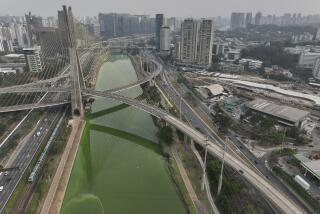Beijing Attempts to Clear Up Choking Air Pollution
BEIJING — Beijing residents who venture west of the city, out past the grimy factories of Capital Steel, often get a pleasant surprise once they’ve passed the industrial zone: blue skies and crystalline air.
Back in the capital, a brown cloud of smog obscures nearby mountains and often buildings just blocks away. Newspapers run features on the best times of day to go outside--before the morning rush begins at 7 a.m. or in the middle of the day, before the evening rush and nighttime cooking and heating with coal stoves foul the air.
Beijing has long been one of the world’s smoggiest cities. But air quality has deteriorated so severely that Premier Zhu Rongjiand other top leaders have ordered drastic cleanup measures.
After one of the smoggiest weeks in a very smoggy year, in mid-December the city announced the “Blue Skies Project”--new regulations meant to clear the roads of the worst polluters and cut dust and smog from construction sites, coal stoves and other sources.
“Air pollution is unavoidable in a fast-growing city like Beijing. But last year it was so bad it was affecting everyone,” says Zhao Yixin, director of the city’s Environmental Protection Bureau.
The new rules sounded the final death knell for the city’s 20,000 “breadbox” minivans--rattletrap vehicles that served as the city’s cheapest taxis.
More than half the tiny yellow vans, known as miandi, were destroyed by the end of December. The last are to be vanquished by the end of 1999.
The minivans accounted for fewer than 2% of Beijing’s more than 1.4 million vehicles, but were the source of 8% to 10% of the pollution caused by auto emissions, city officials say.
“The mass destruction of miandi is necessary to awaken people’s awareness of environmental protection and to make them aware of how surrounded people are by pollution,” Vice Mayor Wang Guangtao declared at a news event at which crusher machines at Capital Steel smashed miandi.
Huge magnets then plucked up the mangled remains and dumped them into blast furnaces.
It’s a strange twist for Capital Steel, which has long been the target of environmentalists alarmed by the haze that drifts eastward across Beijing from the mammoth factory compound.
By 2003, Capital Steel plans to spend nearly $100 million on pollution-prevention projects, such as upgrading its furnaces.
Many city factories, including Capital Steel, have cut production as China’s economy slowed, so authorities are targeting other polluters.
To reduce airborne dust from Beijing’s more than 5,000 construction sites, new rules require contractors to wall off projects and keep adjacent streets free of dust and mud.
Restaurants and other businesses in the city center were supposed to stop burning coal and convert to cleaner fuels by Feb. 15. Traditional courtyard homes that use coal stoves for heating must shift to high-quality coal, which burns cleaner.
In other cleanup measures, city officials banned leaded gasoline and began spot emissions inspections of cars, buses and trucks, ordering that all vehicles sold after Jan. 1 be equipped with catalytic converters.
Progress has been slow. Spot checks on a recent weekend found that roughly two-thirds of inspected vehicles failed emissions tests.
If current trends continue, auto emissions are bound to rise. The number of vehicles on Beijing’s roads quadrupled between 1986 and 1996, and 177,000 new vehicles hit the city’s jammed streets between January and November of last year.
For at least five months last year, the air pollution index was reported at “level four”--severe enough to endanger heart and lung patients and to cause healthy people to develop symptoms such as coughing and sore throats.
Last spring, the state-run news media began publishing weekly air quality reports. As the air grew progressively dirtier, those reports vanished or were buried.
Weather is partly to blame. Last year was unusually warm, and the winds that usually sweep the skies clear in spring and autumn were unusually calm. Frequent temperature inversions trapped smog over the city, which is ringed on three sides by mountains.
Only on windy days do Beijingers see the purple mountain ranges to the west. Most nights, the skies are rosy-gray. City lights glow dimly through a thick haze.
City authorities say they don’t expect blue skies right away. They hope to reduce the number of weeks of “level four” pollution this year to less than 10 from the 22 reported last year.
“It will take some time. Even in the United States it took quite a while,” says Zhao.
“We have to get people to understand that air pollution has something to do with everyone. If you burn dirty coal, if you don’t fix your car properly, then it doesn’t just affect other people; it also affects you.”
More to Read
Sign up for Essential California
The most important California stories and recommendations in your inbox every morning.
You may occasionally receive promotional content from the Los Angeles Times.










